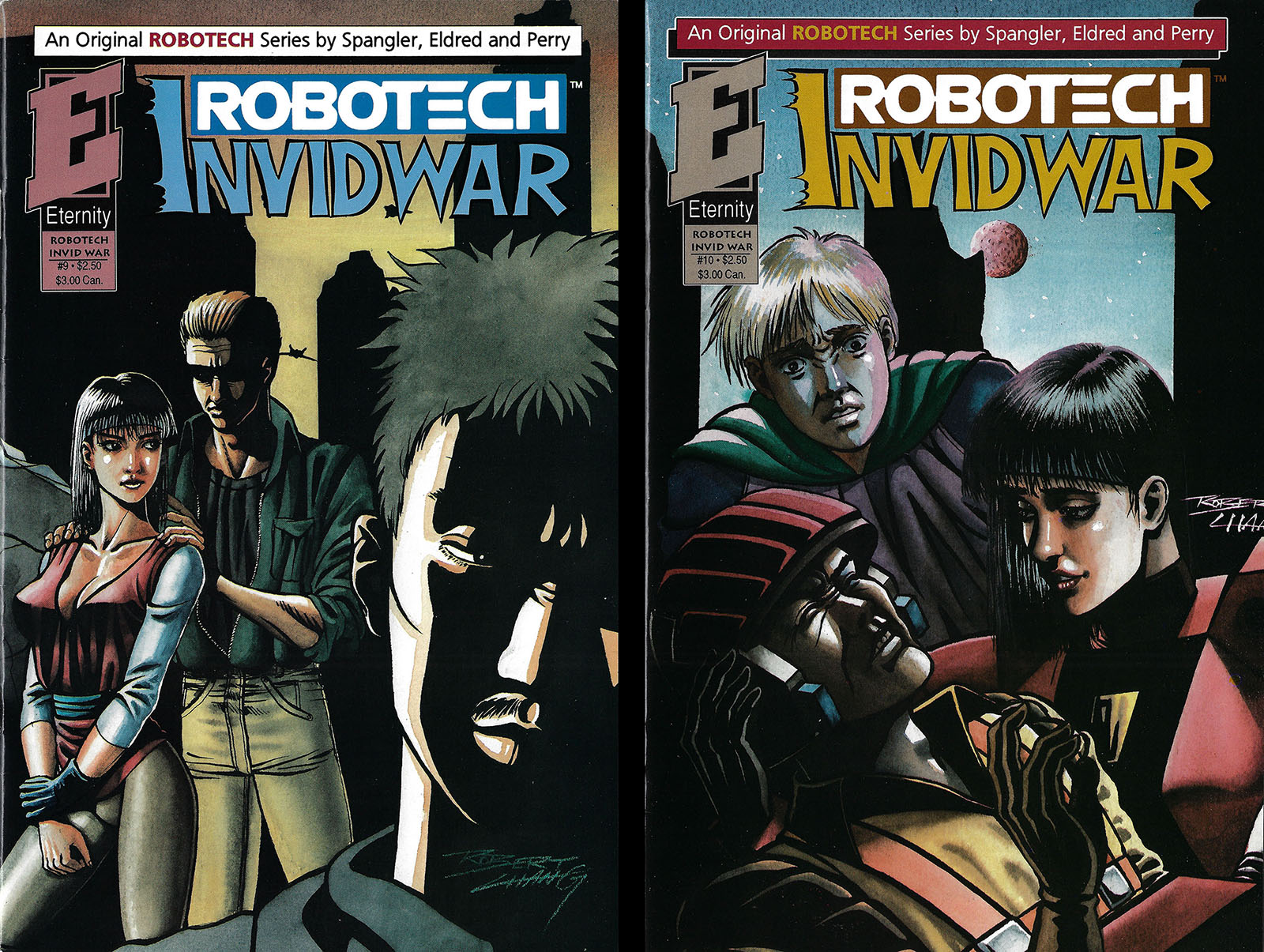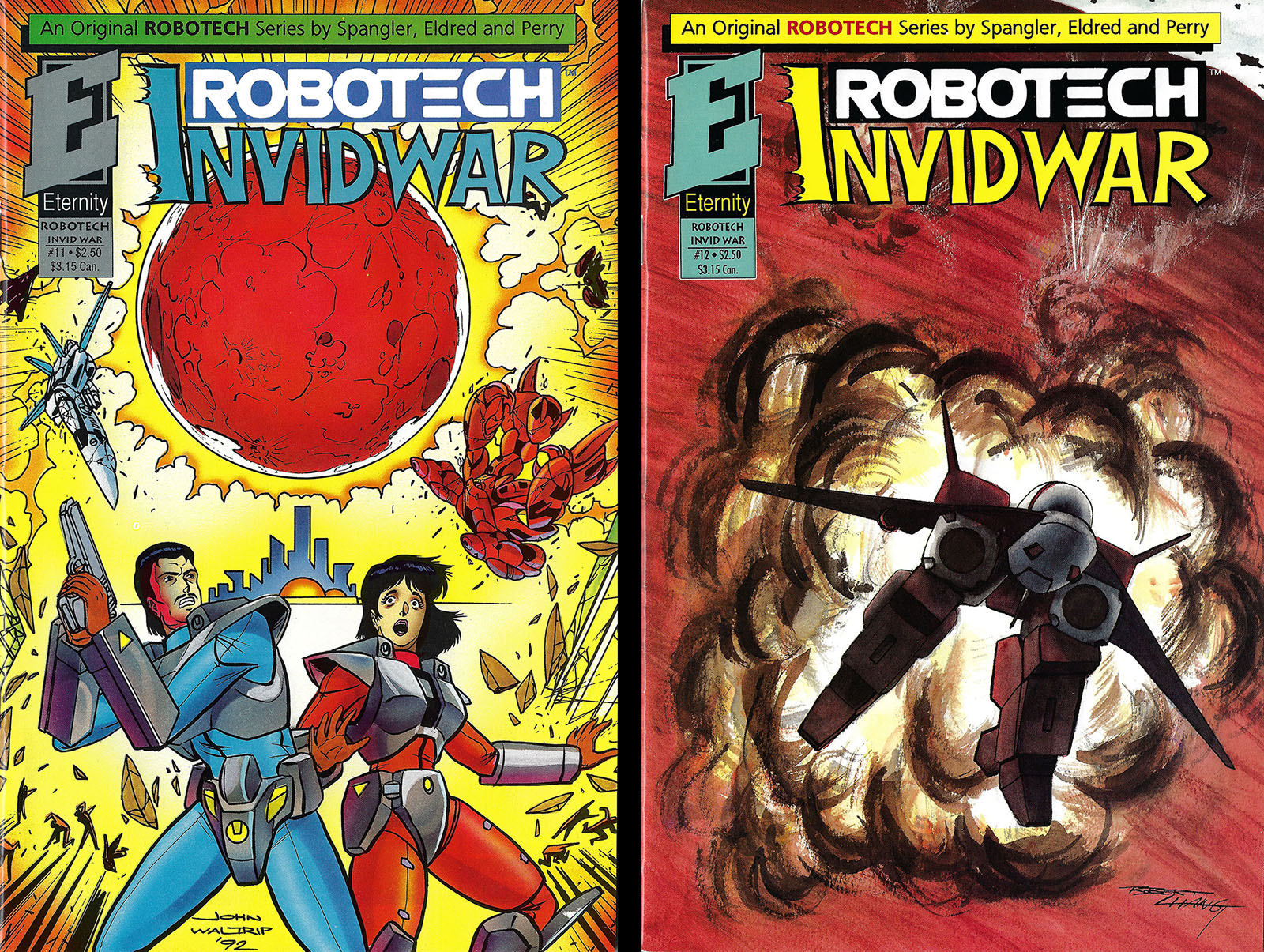Robotech: Invid War issues 9-12, 1993
Sometimes the most important lessons you learn are the ones you didn’t expect. When I got into the biz of making comics, one of those lessons was to never underestimate the power of an inker.
Someone once asked me to describe what an inker brings to a comic book, and my answer was, “It’s all about line weights.” It’s true, but also very reductive. I was referring to the technique of choosing which lines in a drawing should be thick and which should be thin. Inking is the craft of making those choices, which define depth and clarity.
After many more years of experience, my answer has evolved into this: “An inker creates the visual texture of the art.” If you want to see a sample of what I’m talking about, this batch of Robotech comics is a good one to study.
In the development phase, I thought of them as “Invid War III,” a 4-issue arc that would take the story up to the beginning of the third TV series in the Robotech pantheon (called Genesis Climber Mospeada in Japan and The New Generation in the US). When I agreed to take on the series, I committed to 12 issues. That’s all the time I wanted to devote to Robotech.
Inking by Fred Perry
By the time I got to this batch, I was into the second half of Cybersuit Arkadyne, and Grease Monkey was brewing in my head. I wanted to spend as much time as possible on original ideas. But Robotech paid the bills. So when the editor at Eternity said they wanted to keep it going after 12, I had to relent. Anyway, I’m drifting off the topic, so let’s get back to inking.
Fred Perry had been the Invid War inker since the first issue. He was chosen by the editor. I don’t remember being asked to suggest a candidate. Except for Captain Harlock, all of my comics up to that point had been inked by other artists and, with occasional exceptions, they were mostly disappointing to me. It always came down to the “visual texture” I mentioned above. Their work simply didn’t match the texture in my head. (Not their fault, they weren’t hired to be mind readers.) Steve Krueger came close, but one inker who got it exactly right was Ken Branch, on the Lensman miniseries Galactic Patrol. Unsurprisingly, he moved on to bigger things shortly afterward.
I didn’t know Fred Perry, never communicated with him, and don’t remember seeing his work until Invid War #1 came out, but it turned into another disappointment. It was nothing against him personally (it never was, with anyone), we just had different textures in our heads. His technique was to lightly ink everything with basically a single line thickness and then paint over it with ink wash (grey tones) to fill in weight and depth. This gave Invid War a visual texture that was not a good match for my style at all. I was (and still am) much more interested in sharp, high contrast linework that flows with the movement of a subject. The grey tones cancelled all that out, often looking muddy and unfocused. It didn’t help that Eternity comics used cheap greyish newsprint that already looked muddy enough on its own.
Inking by Fred Perry
Fred was hired because he was reliable. He got the work done on time and (more importantly) was willing to work for Eternity’s cheap-ass page rate. That earned him all the slack I had to give. I knew what inkers were being paid, and it was criminally low. The idea was that they’d get royalties to make up for it after a comic went on sale, but it still meant they were essentially working for minimum wage up front. By that reckoning, Eternity was lucky to find any inkers at all.
In the previous batch, you got to see a break in the pattern. Since Fred was fully occupied with the regular Invid War series, I stepped in to ink the “extra issue,” titled Firewalkers. Comparing my inking to Fred’s shows a world of difference. This time around, you’ll see another example.
Back in late 1991/early 1992, I underwent a sort of rite of passage when I started teaching a weekly course in Comic Book Production at a local arts college in Grand Rapids Michigan. I call it that because it placed me directly in the shoes of my first teacher in that same subject, 11 years earlier at that same college. (Which I described here.)
Inking by Anthony Carpenter
Back then, in late 1980, 15-year-old-me walked into that class with daydreams of being recognized and hired for my first professional job in comics. Of course, it didn’t happen. But when I became the teacher, it did…for someone else.
We had about a dozen students (I say we because my friend Scott Rosema was my teaching partner), and one of them stood out immediately. His name was Anthony Carpenter, and every time we issued an assignment he knocked it out of the park. He was clearly ready to move up the ladder, and the second I learned that Fred Perry had to skip an issue of Invid War, I suggested Anthony as a fill in. It would be his first professional assignment. The editor accepted my suggestion, Anthony accepted the terms, and we were off to the races.
Anthony replaced Fred on issue 10, and the results were stunning. He relied on penwork rather than grey tones, and his sense of texture, while different from mine, was a breath of fresh air. It was like clouds parting and sun streaming in to sharpen and clarify everything on the page. I don’t think Anthony watched Robotech or collected toys and models like I did, but it didn’t matter. My job as penciler was to draw all the details accurately. His job as inker was to decide on texture. It didn’t look like any Robotech comic that came before it, and that was just fine with me.
Eternity misspelled Anthony’s name in the credits (a fairly typical editorial flub back then), but thankfully that did no lasting damage. When Fred’s tenure on the series ended with issue 12, Anthony became the regular inker for the rest of the run, up to the finale in issue 18. That, plus the chance to finally merge with anime continuity, did a lot to keep me going after the point where it was supposed to end.
Inking by Anthony Carpenter
More about that next time. Now let’s hear from our old pal, Writer Bill Spangler…
“Sometimes It Works Like That”
by Bill Spangler
So, where were we?
With Invid War #9-12, we turned our attention to Rand, a member of the Robotech New Generation cast. One of the strengths of New Generation, which probably comes in part from the original story, Mospeada, is that it that shows how humans adapted, or failed to adapt, to life under the Invid. So it was a bit of a challenge to give Rand a background we hadn’t seen before.
I decided to make him a preacher’s kid, the son of a minister who was the leader of an isolated settlement. Rand definitely seemed like the classic P.K., a cocky know-it-all who thought the rules didn’t apply to him. The name Somerville came from a road sign I saw. I wish I could tell you I had some profound reason for using it, but that wouldn’t be true. I just thought the Rev. Mr. Somerville had a nice ring to it. Sometimes it works like that. For what it’s worth, I don’t think Rand’s dad had a formal title, like major. I think he was one of the community leaders, and he sort of inherited the role as the other leaders died or left.
I liked to add new mecha to the scripts whenever I could, and that wasn’t hard to do with Invid War, because I could bring in mecha from decades of combat. Coming up with new names was fun, too. One my favorites was the Cestus battlesuit, from the first Invid War storyline.
One of the new mecha in this arc was the Invid inorganic mecha called the Ferret. Since my wife Joyce and I were proud ferret owners at that point, introducing a mecha with that name seemed like an obvious choice. Sometimes it works like that.
Bill and his wife Joyce are facing serious financial issues due to a series of medical emergencies colliding with a series of household emergencies, and they urgently need your help. For more information on what you can do, click here.
Issue 9: Last Stop on the Lunar Railroad
Production period: February/March 1992
Published January 1993
Issue 10: Red Moon Rising
Production period: March/April 1992
Published February 1993
Issue 11: Under a Blood Red Sky
Production period: April/May 1992
Published March 1993
Issue 12: Moonfall
Production period: May/June 1992
Published April 1993






